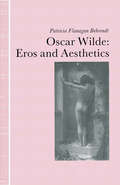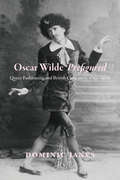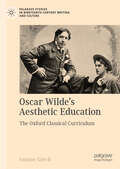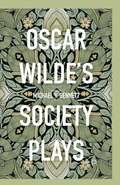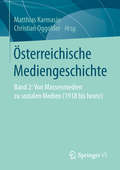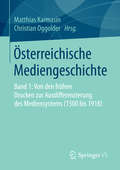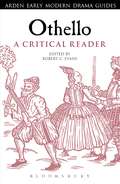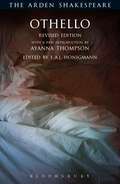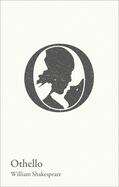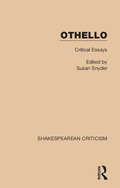- Table View
- List View
Oscar Wilde Eros and Aesthetics
by Patricia Flanagan BehrendtThis study explores the relationship between Wilde's treatment of sexual subject matter and the development of his literary aesthetics from the earliest volume of poetry through the social comedies which highlighted his career. In addition, the study considers the earliest critical responses to Wilde's works, since they reveal how references to sexual subject matter, particularly to homoerotic themes, were received in Wilde's own period.
Oscar Wilde Prefigured: Queer Fashioning and British Caricature, 1750-1900
by Dominic Janes“I do not say you are it, but you look it, and you pose at it, which is just as bad,” Lord Queensbury challenged Oscar Wilde in the courtroom—which erupted in laughter—accusing Wilde of posing as a sodomite. What was so terrible about posing as a sodomite, and why was Queensbury’s horror greeted with such amusement? In Oscar Wilde Prefigured, Dominic Janes suggests that what divided the two sides in this case was not so much the question of whether Wilde was or was not a sodomite, but whether or not it mattered that people could appear to be sodomites. For many, intimations of sodomy were simply a part of the amusing spectacle of sophisticated life. Oscar Wilde Prefigured is a study of the prehistory of this “queer moment” in 1895. Janes explores the complex ways in which men who desired sex with men in Britain had expressed such interests through clothing, style, and deportment since the mid-eighteenth century. He supplements the well-established narrative of the inscription of sodomitical acts into a homosexual label and identity at the end of the nineteenth century by teasing out the means by which same-sex desires could be signaled through visual display in Georgian and Victorian Britain. Wilde, it turns out, is not the starting point for public queer figuration. He is the pivot by which Georgian figures and twentieth-century camp stereotypes meet. Drawing on the mutually reinforcing phenomena of dandyism and caricature of alleged effeminates, Janes examines a wide range of images drawn from theater, fashion, and the popular press to reveal new dimensions of identity politics, gender performance, and queer culture.
Oscar Wilde Prefigured: Queer Fashioning and British Caricature, 1750-1900
by Dominic Janes“I do not say you are it, but you look it, and you pose at it, which is just as bad,” Lord Queensbury challenged Oscar Wilde in the courtroom—which erupted in laughter—accusing Wilde of posing as a sodomite. What was so terrible about posing as a sodomite, and why was Queensbury’s horror greeted with such amusement? In Oscar Wilde Prefigured, Dominic Janes suggests that what divided the two sides in this case was not so much the question of whether Wilde was or was not a sodomite, but whether or not it mattered that people could appear to be sodomites. For many, intimations of sodomy were simply a part of the amusing spectacle of sophisticated life. Oscar Wilde Prefigured is a study of the prehistory of this “queer moment” in 1895. Janes explores the complex ways in which men who desired sex with men in Britain had expressed such interests through clothing, style, and deportment since the mid-eighteenth century. He supplements the well-established narrative of the inscription of sodomitical acts into a homosexual label and identity at the end of the nineteenth century by teasing out the means by which same-sex desires could be signaled through visual display in Georgian and Victorian Britain. Wilde, it turns out, is not the starting point for public queer figuration. He is the pivot by which Georgian figures and twentieth-century camp stereotypes meet. Drawing on the mutually reinforcing phenomena of dandyism and caricature of alleged effeminates, Janes examines a wide range of images drawn from theater, fashion, and the popular press to reveal new dimensions of identity politics, gender performance, and queer culture.
Oscar Wilde Prefigured: Queer Fashioning and British Caricature, 1750-1900
by Dominic Janes“I do not say you are it, but you look it, and you pose at it, which is just as bad,” Lord Queensbury challenged Oscar Wilde in the courtroom—which erupted in laughter—accusing Wilde of posing as a sodomite. What was so terrible about posing as a sodomite, and why was Queensbury’s horror greeted with such amusement? In Oscar Wilde Prefigured, Dominic Janes suggests that what divided the two sides in this case was not so much the question of whether Wilde was or was not a sodomite, but whether or not it mattered that people could appear to be sodomites. For many, intimations of sodomy were simply a part of the amusing spectacle of sophisticated life. Oscar Wilde Prefigured is a study of the prehistory of this “queer moment” in 1895. Janes explores the complex ways in which men who desired sex with men in Britain had expressed such interests through clothing, style, and deportment since the mid-eighteenth century. He supplements the well-established narrative of the inscription of sodomitical acts into a homosexual label and identity at the end of the nineteenth century by teasing out the means by which same-sex desires could be signaled through visual display in Georgian and Victorian Britain. Wilde, it turns out, is not the starting point for public queer figuration. He is the pivot by which Georgian figures and twentieth-century camp stereotypes meet. Drawing on the mutually reinforcing phenomena of dandyism and caricature of alleged effeminates, Janes examines a wide range of images drawn from theater, fashion, and the popular press to reveal new dimensions of identity politics, gender performance, and queer culture.
Oscar Wilde Prefigured: Queer Fashioning and British Caricature, 1750-1900
by Dominic Janes“I do not say you are it, but you look it, and you pose at it, which is just as bad,” Lord Queensbury challenged Oscar Wilde in the courtroom—which erupted in laughter—accusing Wilde of posing as a sodomite. What was so terrible about posing as a sodomite, and why was Queensbury’s horror greeted with such amusement? In Oscar Wilde Prefigured, Dominic Janes suggests that what divided the two sides in this case was not so much the question of whether Wilde was or was not a sodomite, but whether or not it mattered that people could appear to be sodomites. For many, intimations of sodomy were simply a part of the amusing spectacle of sophisticated life. Oscar Wilde Prefigured is a study of the prehistory of this “queer moment” in 1895. Janes explores the complex ways in which men who desired sex with men in Britain had expressed such interests through clothing, style, and deportment since the mid-eighteenth century. He supplements the well-established narrative of the inscription of sodomitical acts into a homosexual label and identity at the end of the nineteenth century by teasing out the means by which same-sex desires could be signaled through visual display in Georgian and Victorian Britain. Wilde, it turns out, is not the starting point for public queer figuration. He is the pivot by which Georgian figures and twentieth-century camp stereotypes meet. Drawing on the mutually reinforcing phenomena of dandyism and caricature of alleged effeminates, Janes examines a wide range of images drawn from theater, fashion, and the popular press to reveal new dimensions of identity politics, gender performance, and queer culture.
Oscar Wilde, Wilfred Owen, and Male Desire: Begotten, Not Made (Palgrave Studies in Nineteenth-Century Writing and Culture)
by James CampbellThis book reads Oscar Wilde as a queer theorist and Wilfred Owen as his symbolic son. It centers on the concept of 'male procreation', or the generation of new ideas through an erotic but non-physical connection between two men, and it sees Owen as both a product and a continuation of this Wildean tradition.
Oscar Wilde's Aesthetic Education: The Oxford Classical Curriculum (Palgrave Studies in Nineteenth-Century Writing and Culture)
by Leanne GrechThis book focuses on the role that the Oxford classical curriculum has had in shaping Oscar Wilde’s aestheticism. It positions Wilde as a classically trained intellectual and outlines the path he took to gain recognition as a writer and promoter of the aesthetic movement. This narrative is conveyed through a broad range of literary sources, including Wilde’s travel poetry, American lectures, and canonical works like ‘The Critic as Artist’, The Soul of Man, The Picture of Dorian Gray and De Profundis. This study proposes that Wilde approached aestheticism as a personalised, self-directed learning experience – a mode of self-culture – which could be used to maintain an intellectual life outside of the university. It also explores Wilde’s thoughts on education and considers the significance of male friendship at Oxford, and in Wilde’s life and literature.
Oscar Wilde's Society Plays
by Michael Y. BennettAs the first collection of essays about Oscar Wilde's comedies, the contributors re-evaluate Oscar Wilde's society plays as 'comedies of manners" to see whether this is actually an apt way to read Wilde's most emblematic plays. Focusing on both the context and the texts, the collection locates Wilde both in his social and literary contexts.
Osip Mandelstam and the Modernist Creation of Tradition
by Clare CavanaghIf modernism marked, as some critics claim, an "apocalypse of cultural community," then Osip Mandelstam (1891-1938) must rank among its most representative figures. Born to Central European Jews in Warsaw on the cusp of the modern age, he could claim neither Russian nor European traditions as his birthright. Describing the poetic movement he helped to found, Acmeism, as a "yearning for world culture," he defined the impulse that charges his own poetry and prose. Clare Cavanagh has written a sustained study placing Mandelstam's "remembrance and invention" of a usable poetic past in the context of modernist writing in general, with particular attention to the work of T. S. Eliot and Ezra Pound.Cavanagh traces Mandelstam’s creation of tradition from his earliest lyrics to his last verses, written shortly before his arrest and subsequent death in a Stalinist camp. Her work shows how the poet, generalizing from his own dilemmas and disruptions, addressed his epoch’s paradoxical legacy of disinheritance--and how he responded to this unwelcome legacy with one of modernism’s most complex, ambitious, and challenging visions of tradition. Drawing on not only Russian and Western modernist writing and theory, but also modern European Jewish culture, Russian religious thought, postrevolutionary politics, and even silent film, Cavanagh traces Mandelstam’s recovery of a "world culture" vital, vast, and varied enough to satisfy the desires of the quintessential outcast modernist.
Osip Mandelstam and the Modernist Creation of Tradition
by Clare CavanaghIf modernism marked, as some critics claim, an "apocalypse of cultural community," then Osip Mandelstam (1891-1938) must rank among its most representative figures. Born to Central European Jews in Warsaw on the cusp of the modern age, he could claim neither Russian nor European traditions as his birthright. Describing the poetic movement he helped to found, Acmeism, as a "yearning for world culture," he defined the impulse that charges his own poetry and prose. Clare Cavanagh has written a sustained study placing Mandelstam's "remembrance and invention" of a usable poetic past in the context of modernist writing in general, with particular attention to the work of T. S. Eliot and Ezra Pound.Cavanagh traces Mandelstam’s creation of tradition from his earliest lyrics to his last verses, written shortly before his arrest and subsequent death in a Stalinist camp. Her work shows how the poet, generalizing from his own dilemmas and disruptions, addressed his epoch’s paradoxical legacy of disinheritance--and how he responded to this unwelcome legacy with one of modernism’s most complex, ambitious, and challenging visions of tradition. Drawing on not only Russian and Western modernist writing and theory, but also modern European Jewish culture, Russian religious thought, postrevolutionary politics, and even silent film, Cavanagh traces Mandelstam’s recovery of a "world culture" vital, vast, and varied enough to satisfy the desires of the quintessential outcast modernist.
Osip Mandelstam and the Modernist Creation of Tradition
by Clare CavanaghIf modernism marked, as some critics claim, an "apocalypse of cultural community," then Osip Mandelstam (1891-1938) must rank among its most representative figures. Born to Central European Jews in Warsaw on the cusp of the modern age, he could claim neither Russian nor European traditions as his birthright. Describing the poetic movement he helped to found, Acmeism, as a "yearning for world culture," he defined the impulse that charges his own poetry and prose. Clare Cavanagh has written a sustained study placing Mandelstam's "remembrance and invention" of a usable poetic past in the context of modernist writing in general, with particular attention to the work of T. S. Eliot and Ezra Pound.Cavanagh traces Mandelstam’s creation of tradition from his earliest lyrics to his last verses, written shortly before his arrest and subsequent death in a Stalinist camp. Her work shows how the poet, generalizing from his own dilemmas and disruptions, addressed his epoch’s paradoxical legacy of disinheritance--and how he responded to this unwelcome legacy with one of modernism’s most complex, ambitious, and challenging visions of tradition. Drawing on not only Russian and Western modernist writing and theory, but also modern European Jewish culture, Russian religious thought, postrevolutionary politics, and even silent film, Cavanagh traces Mandelstam’s recovery of a "world culture" vital, vast, and varied enough to satisfy the desires of the quintessential outcast modernist.
Österreichische Mediengeschichte
by Matthias Karmasin Christian OggolderDer Band legt eine Mediengeschichte des Landes im Sinne einer Kultur- und Gesellschaftsgeschichte vor. Dieser sozial- und kulturhistorische Zugang geht von einer Wechselwirkung gesellschaftlicher Entwicklungen und medialer Veränderungen aus. Im Zentrum des Interesses steht daher nicht die exakte Rekonstruktion von Entwicklungslinien einzelner Mediengattungen in Österreich, sondern gerade diese Interdependenzen von gesellschaftlichen und politischen Veränderungen sowie medialen Entwicklungen und Innovationen. Im zweiten Band liegt der Schwerpunkt auf dem Zeitraum 1918 bis heute.
Österreichische Mediengeschichte: Band 1: Von den frühen Drucken zur Ausdifferenzierung des Mediensystems (1500 bis 1918)
by Matthias Karmasin Christian OggolderDer Band legt eine Mediengeschichte des Landes im Sinne einer Kultur- und Gesellschaftsgeschichte vor. Dieser sozial- und kulturhistorische Zugang geht von einer Wechselwirkung gesellschaftlicher Entwicklungen und medialer Veränderungen aus. Im Zentrum des Interesses steht daher nicht die exakte Rekonstruktion von Entwicklungslinien einzelner Mediengattungen in Österreich, sondern gerade diese Interdependenzen von gesellschaftlichen und politischen Veränderungen sowie medialen Entwicklungen und Innovationen.
Othello (The RSC Shakespeare)
by Jonathan Bate Eric RasmussenFrom the Royal Shakespeare Company – a modern, definitive edition of Shakespeare’s magnificent tragedy of love, jealousy and explosive racial politics. With an expert introduction by Sir Jonathan Bate, this unique edition presents a historical overview of Othello in performance, takes a detailed look at specific productions, and recommends film versions. Included in this edition are interviews with two leading directors and an actor – Trevor Nunn, Michael Attenborough and Antony Sher – providing an illuminating insight into the extraordinary variety of interpretations that are possible. This edition also includes an essay on Shakespeare’s career and Elizabethan theatre, and enables the reader to understand the play as it was originally intended – as living theatre to be enjoyed and performed. Ideal for students, theatre-goers, actors and general readers, the RSC Shakespeare editions offer a fresh, accessible and contemporary approach to reading and rediscovering Shakespeare’s works for the twenty-first century.
Othello: A Critical Reader (Arden Early Modern Drama Guides)
by Robert C. EvansOthello has long been, and remains, one of Shakespeare's most popular works. It is a favourite work of scholars, students, and general readers alike. Perhaps more than any other of Shakespeare's tragedies, this one seems to speak most clearly to contemporary readers and audiences, partly because it deals with such pressing modern issues as race, gender, multiculturalism, and the ways love, jealousy, and misunderstanding can affect relations between romantic partners. The play also features Iago, one of Shakespeare's most mesmerizing and puzzling villains. This guide offers students and scholars an introduction to the play's critical and performance history, including notable stage productions and film versions. It includes a keynote chapter outlining major areas of current research on the play and four new critical essays. Finally, a guide to critical, web-based and production-related resources and an annotated bibliography provide a basis for further research.
Othello: A Critical Reader (Arden Early Modern Drama Guides)
by Robert C. EvansOthello has long been, and remains, one of Shakespeare's most popular works. It is a favourite work of scholars, students, and general readers alike. Perhaps more than any other of Shakespeare's tragedies, this one seems to speak most clearly to contemporary readers and audiences, partly because it deals with such pressing modern issues as race, gender, multiculturalism, and the ways love, jealousy, and misunderstanding can affect relations between romantic partners. The play also features Iago, one of Shakespeare's most mesmerizing and puzzling villains. This guide offers students and scholars an introduction to the play's critical and performance history, including notable stage productions and film versions. It includes a keynote chapter outlining major areas of current research on the play and four new critical essays. Finally, a guide to critical, web-based and production-related resources and an annotated bibliography provide a basis for further research.
Othello: Language and Writing (Arden Student Skills: Language and Writing)
by Laurie MaguireIn this volume on Othello, Laurie Maguire examines the use and misuse of language, the play's textual and performance histories and how critics and directors have responded to the language of sexual jealousy.
Othello: Language And Writing (Arden Student Skills: Language and Writing)
by Laurie MaguireIn this volume on Othello, Laurie Maguire examines the use and misuse of language, the play's textual and performance histories and how critics and directors have responded to the language of sexual jealousy.
Othello: The State of Play (Arden Shakespeare The State of Play)
by Lena Cowen OrlinOthello has a long history of provoking profound emotion in its audiences and readers. This 'freeze frame' volume showcases current debates and ideas about the play's provocative effects. Each chapter has been carefully selected for its originality and relevance to the needs of students, teachers, and researchers. Key issues and themes include: - Gender, Love, and Desire - Race, Ethnicity, and Difference - Social Relations, Status, and Ambition - Tragedy, Comedy, and Parody - Language, Expression, and Characterization All the essays offer new perspectives and combine to give readers an up-to-date understanding of what's exciting and challenging about Othello. The approach based on an individual play, unlike that of topic-based series, reflects how Shakespeare is most commonly studied and taught.
Othello: The State of Play (Arden Shakespeare The State of Play)
by Lena Cowen OrlinOthello has a long history of provoking profound emotion in its audiences and readers. This 'freeze frame' volume showcases current debates and ideas about the play's provocative effects. Each chapter has been carefully selected for its originality and relevance to the needs of students, teachers, and researchers. Key issues and themes include: - Gender, Love, and Desire - Race, Ethnicity, and Difference - Social Relations, Status, and Ambition - Tragedy, Comedy, and Parody - Language, Expression, and Characterization All the essays offer new perspectives and combine to give readers an up-to-date understanding of what's exciting and challenging about Othello. The approach based on an individual play, unlike that of topic-based series, reflects how Shakespeare is most commonly studied and taught.
Othello: Character Studies (Character Studies)
by Nicholas PotterOthello is a major shakespearean text, studiedwidely and often adapted for film and TV and isespecially challenging for a multicultural society.Othello lends itself to criticism through discussion ofthe major characters although this study also focuseson recent criticism's analysis of the characters as"signifiers". The study of the key characters takesthe discussion of the text immediately into thecentral issues of "otherness", gender, race andpower.
Othello: Revised Edition (The Arden Shakespeare Third Series)
by William ShakespeareThis second edition of Othello has a new, illustrated introduction by leading American scholar Ayanna Thompson, which addresses such key issues as race, religion and gender, as well as looking at ways in which the play has been adapted in more recent times.Othello is one of Shakespeare's great tragedies-written in the same five-year period as Hamlet, King Lear, and Macbeth. The new introduction attends to the play's different meanings throughout history, while articulating the historical context in which Othello was created, paying particular attention to Shakespeare's source materials and the evidence about early modern constructions of racial and religious difference. It also explores the life of the play in different historical moments, demonstrating how meanings and performances develop, accrue, and metamorphose over time. The volume provides a rich and current resource, making this best-selling play edition ideal for today's students at advanced school and undergraduate level.
OTHELLO: A-level and GCSE 9-1 set text student edition (PDF)
by William ShakespeareThis edition of Othello is perfect for A-level and GCSE 9-1 students, with the complete play in an accessible format, on-page notes, introduction setting the context, timeline, character and theme indexes. Affordable high quality complete play for Othello Demystify vocabulary with notes on the page and concise commentary Set the scene with perfectly pitched introductions that introduce key contexts, concerns and stylistic features, and examine different performances and interpretations Recall plot summaries at the beginning of each scene Support GCSE and A Level revision and essay writing with theme and character indexes Help with social, historical and literary context with the bespoke timeline of Shakespeare’s life and times
Othello: Revised Edition (The Arden Shakespeare Third Series)
by William Shakespeare Ayanna Thompson E.A.J. HonigmannThis second edition of Othello has a new, illustrated introduction by leading American scholar Ayanna Thompson, which addresses such key issues as race, religion and gender, as well as looking at ways in which the play has been adapted in more recent times.Othello is one of Shakespeare's great tragedies-written in the same five-year period as Hamlet, King Lear, and Macbeth. The new introduction attends to the play's different meanings throughout history, while articulating the historical context in which Othello was created, paying particular attention to Shakespeare's source materials and the evidence about early modern constructions of racial and religious difference. It also explores the life of the play in different historical moments, demonstrating how meanings and performances develop, accrue, and metamorphose over time. The volume provides a rich and current resource, making this best-selling play edition ideal for today's students at advanced school and undergraduate level.
Othello: Critical Essays (Shakespearean Criticism)
by Susan SnyderOriginally published in 1988. Selections here are organised chronologically looking at both theatrical commentary and literary criticism. The organisation brings out the shifts in emphasis as each generation reinvents Shakespeare, and Othello, by the questions asked, those not asked, and the answers given. Chapters cover the theme of heroic action, Iago’s motivation, guilt and jealousy, and obsession. Some entries from the world of theatre delve into the portrayal of the Moor, Desdemona and Iago from the 1940s on. Authors include A. C. Bradley, William Hazlitt, Ellen Terry, Konstantin Stanislavsky, Helen Gardner and Edward A. Snow.
